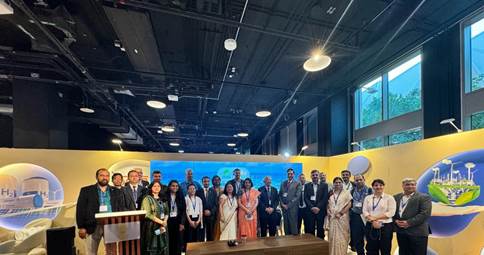Verghese V Joseph –
Bengaluru: November 05, 2023 – At a side event organized by the Department of Science and Technology (DST) and held on December 3, 2023, at the India pavilion at the UN Climate Conference COP 28, Dr. Anita Gupta, Head, Climate Change and Clean Energy Division, who led the discussions at the two sessions at the side event, emphasized the need for immediate action in light of the worsening effects of climate change and informed the international audience about India’s climate change initiatives.
In the first session, participants discussed the Climate Change Programme (CCP) under the National Action Plan on Climate Change of the Indian government; vulnerability and risk assessment in India; regional perspective on cryosphere; climate risk profile for adaptation plan in Manipur state; and inclusive climate actions for sustainable development of IHR. Representatives from Switzerland Development Corporation (SDC), International Centre for Integrated Mountain Development (ICIMOD), Nepal; Directorate of Environment and Climate Change, Manipur, India; GBPNIHE, Almora, India, and DST, India, participated in the discussions.
In the second session, which was co-hosted by the Himachal Pradesh government and the Department of Science and Technology, participants highlighted the National Mission on Sustaining the Himalayan Ecosystem’s initiatives, while the government representatives discussed current climate policy interventions, such as the Climate Risk Assessment (CRA) for the development of ecologically-oriented resilient villages with climate-resilient agricultural and horticultural practices.
India’s climate is strongly influenced by the Himalayan range, and the Indian Himalayan region (IHR) has provided refuge to over 50 million people. Any change to the Himalayas would have an impact on millions of people’s lives throughout the entire subcontinent, not just in India. These include modifications brought about by natural causes, anthropogenic emissions-induced climate change, and developmental pathways. Thus, evaluating the Indian Himalayan region’s vulnerability becomes imperative.
In addition, strategies for establishing “Climate Resilient Development” in the Indian Himalayan Region by fostering resilient and environmentally conscious mountain communities were explored, as well as the effects and ramifications of climate change vulnerability in the region.
Representatives from 197 nations are exhibiting their efforts to combat global warming and get ready for future climate change at the 28th Conference of Parties, which is being place in Dubai, United Arab Emirates (UAE), from November 30 to December 12, 2023. This is the initial instance in which nations formally evaluate their advancements in accordance with the 2015 Paris Climate Agreement.
In order to address climate change and accomplish major progress in the upcoming years, the COP 28 participants also talked about adaptation and mitigation measures. The world’s delicate ecosystems, like the Himalayan Mountain Range in Asia, and very susceptible nations like them both greatly depend on such initiatives.
The experts at the side event discussed the significance of the National Mission for Sustaining the Himalayan Ecosystem (NMSHE), which was launched as part of the National Action Plan on Climate Change (NAPCC), in better understanding the links between climate change and the Himalayan ecosystem for improved adaptation. DST officials such as Dr Susheela Negi and other domain experts discussed ways to move this mission forward for long-term climate change solutions, which the Department of Science and Technology (DST) is coordinating, implementing, and monitoring in collaboration with several other central ministries and all Himalayan States/Union territories.

